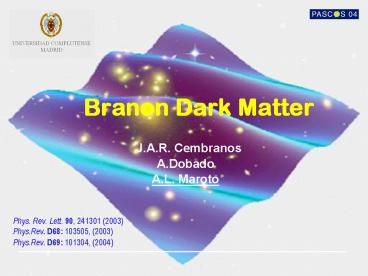Branon Dark Matter - PowerPoint PPT Presentation
1 / 14
Title:
Branon Dark Matter
Description:
Antonio L. Maroto. 6. Brane orientation branons are pseudoscalar particles ... Antonio L. Maroto. 7. Branon cosmic abundance. Freeze-out in an expanding universe: ... – PowerPoint PPT presentation
Number of Views:89
Avg rating:3.0/5.0
Title: Branon Dark Matter
1
(No Transcript)
2
Introduction brane fluctuations
- - Rigid branes ( f gtgt
MD) - KK modes
- Brane-world
- scenario
- (ADD, 98) - Flexible branes
(f ltlt MD) - Branon fields
- (KK modes
decouple from SM) - Bando et al. 99
3
Brane fluctuations
- Bulk metric
- Brane position
- Branon fields
- Branon mass related to bulk curvature
4
Branon dynamics
- Induced metric on the brane
- Dirac-Nambu-Goto action
- Branon effective action Sundrum
99, Dobado A.L.M 01
5
Limits from colliders
- Induced metric on the brane
- Dirac - Nambu - Goto action
- Branon action
LEP-II ...
TEVATRON-I
...
hep-ex/0407017
6
A new dark matter candidate
- Brane orientation branons are
pseudoscalar particles - Parity on the brane branons
couple by pairs to SM
.
(stable particles) - Branons are stable, massive and weakly
interacting particles - NATURAL DARK MATTER CANDIDATES
7
Branon cosmic abundance
Freeze-out in an expanding universe Annihila
tion into all SM pairs X
, e.g. annihilation into
photons,
Cold branons (M gtgt T) Hot
branons (M ltlt T)
8
Branon cosmic abundance
Cold branons WMAP limits
9
Branon cosmic abundance
Hot branons
WMAP
WMAP-CBI-ACBAR-2dF-Ly-a
BBN limits for
10
Combined limits
11
Direct detection
Elastic branon-nucleon
cross section
(spin independent)
12
Non-thermal branon production
If TRHltlt Tf and TRH gtgt L (L explicit
symmetry breaking scale). Branons are essentially
massless and decoupled from SM. Brane initial
position Y0 O (RB) and p0 f 2 RB Dark
matter as coherent brane oscillations (similar to
axions) If H(T) gt G(T) for T lt TRH brane
oscillations only diluted by Hubble expansion.
Non-thermal branon abundance
13
Cosmic coincidence problem
AdS6 soliton solution Branon
mass Fundamental scale
Bulk C.C. (loop
effects)
14
Conclusions and future perspectives
- Branons are natural dark matter candidates in
brane-world - models.
- Produced as thermal or non-thermal relics
(cosmic coincidence) - ... or strongly self-interacting dark matter.
- They could be detected in future direct search
experiments (CDMS, CRESST II, ...). - Indirect detection from halo annihilations into
photons or ee- by MAGIC, GLAST or AMS (coll.). - Indirect detection by ANTARES, IceCube, ...
from annihilation into high-energy neutrinos. - L3 coll. direct searches (published results)
- Future searches at hadronic (LHC) or Linear
Colliders.

